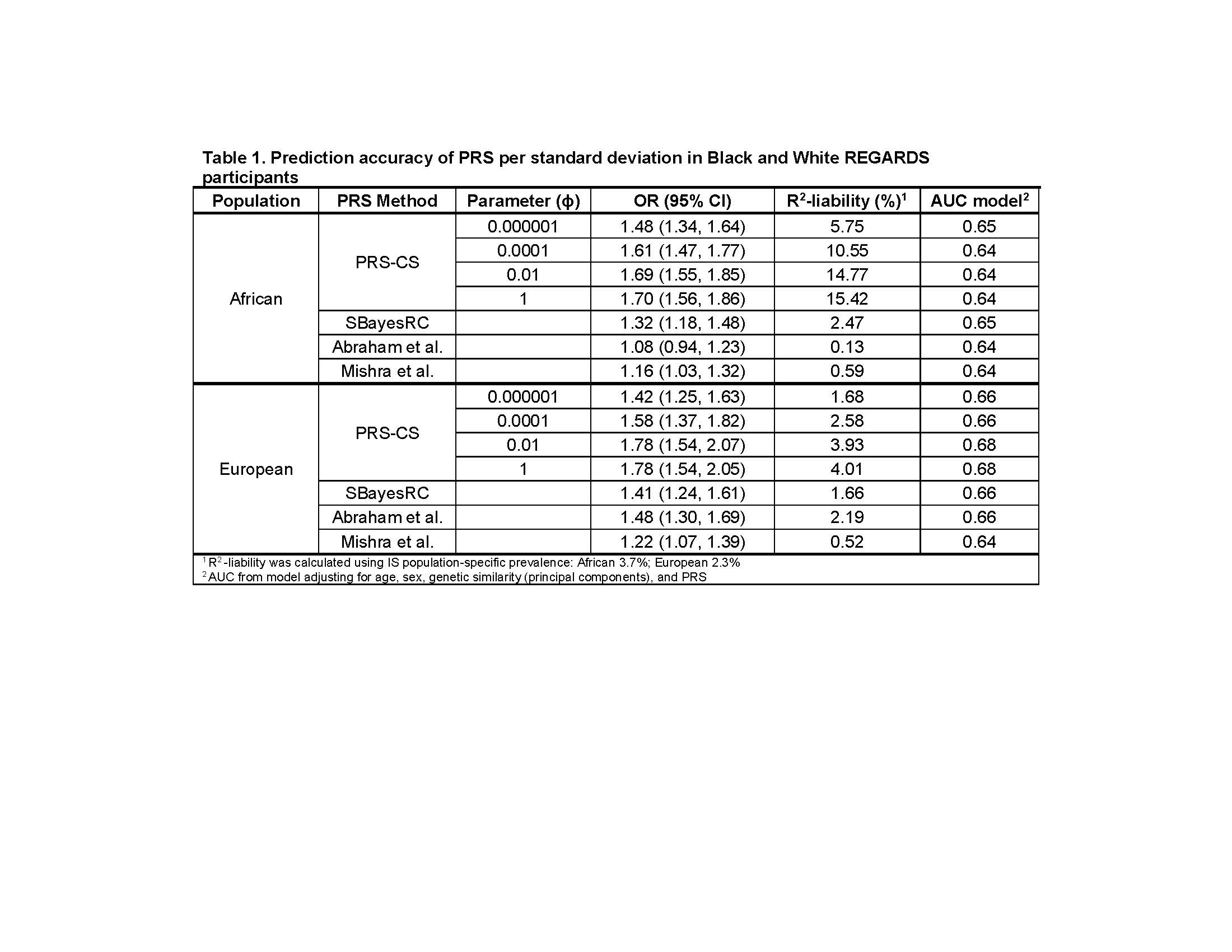Final ID: P2102
Enhancing Ischemic Stroke Risk Prediction: Functional Genomic Insights in Black and White Participants from the Reasons for Geographic and Racial Differences in Stroke (REGARDS) Study
Abstract Body: Genome-wide association studies (GWAS) have advanced our understanding of the polygenic basis of complex human diseases. Although translating GWAS findings into clinical application remains difficult, polygenic risk scores (PRS) offer a potential approach. PRS methods aim to improve prediction, with Bayesian approaches like PRS-CS and functional-based methods such as SBayesRC. This study compares these two methods for incident ischemic stroke (IS) in Black and White participants from the Reasons for Geographic and Racial Differences in Stroke (REGARDS) study. We hypothesize that including functional annotations using SBayesRC will (1) improve IS polygenic prediction compared to PRS-CS and (2) outperform previous scores. Using summary statistics from the GIGASTROKE consortium (African ancestry n=20,924 [894 cases]; European ancestry n=1,296,908 [62,100 cases]), we developed IS PRS using SBayesRC and PRS-CS (four parameterizations, phi) for 6,569 Black (436 cases) and 1,544 White (368 cases) REGARDS participants. We applied the effect weights of two published IS PRS (Abraham and Mishra) in REGARDS. Performance was evaluated by the (1) proportion of variation in IS explained by the PRS on the liability scale (Nagelkerke’s R2), (2) odds ratio (OR) per standard deviation (SD), and (3) the area under the curve (AUC), adjusting for age, sex, and genetic similarity. In REGARDS Black participants, the PRS constructed by SBayesRC explained 2.47% of the IS variation, with OR of 1.32 (1.18-1.48). While this score had stronger prediction compared to the Abraham (R2=0.13%, OR=1.08 [0.94, 1.23]) and Mishra (R2=0.59%, OR=1.16 [1.03, 1.32]) scores, PRS-CS (phi=0.01) explained 14.77% of the variation in IS, with OR of 1.69 (1.55-1.85). Among White participants, the best performing PRS was also from PRS-CS (phi=0.01) (R2=3.93%, OR=1.78 [1.54-2.07]). SBayesRC (R2=1.66%, OR=1.41 [1.24-1.61]) had stronger prediction compared to the Mishra score (R2=0.52%, OR=1.22 [1.07-1.39]) but was similar to the Abraham score (R2=2.19%, OR=1.48 [1.30-1.69]) (Table 1). In Black and White participants from REGARDS, adding functional annotation improved PRS prediction for IS compared to prior scores, although not as effectively as PRS-CS using large, single ancestry summary statistics. Additional validation is ongoing using data available in All of Us. In conclusion, this study underscores the need for large ancestry-specific summary statistics for PRS development.
More abstracts on this topic:
A Multi-Population-First Approach Leveraging UK Biobank (UKBB) and All of Us (AoU) Datasets Reveals Higher Cardiomyopathy Variant Burden in Individuals with Myocarditis
Gurumoorthi Manasa, Khanji Mohammed, Munroe Patricia, Petersen Steffen, Landstrom Andrew, Chahal Anwar, Hesse Kerrick, Asatryan Babken, Shah Ravi, Sharaf Dabbagh Ghaith, Wolfe Rachel, Shyam Sundar Vijay, Mohiddin Saidi, Aung Nay
3-HKA Promotes the Vascular Remodeling after Stroke by Modulating the Activation of A1/A2 Reactive AstrocytesChen Jun-min, Shi Guang, Yu Lulu, Shan Wei, Zhang Xiangjian, Wang Qun

